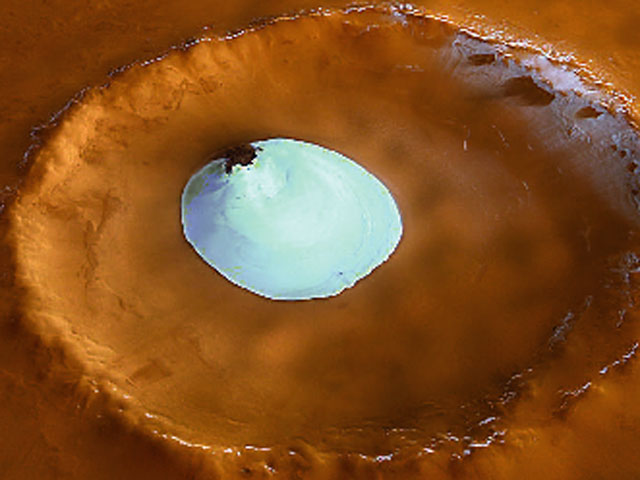
Posted on 12/12/2006 7:31:08 PM PST by KevinDavis
The planet Mars is a glutton for punishment.
Scientists have found no less than 20 new craters etched into the red planet’s surface from space rocks that pummeled Mars within the last seven years [image].
“If you were to live on Mars for about 20 years, you would live close enough to one of these events to hear it,” said researchers Michael Malin, who led the study. “So there’d be a big boom and you’d know there was an impact crater.”
Malin, chief scientist at San Diego, California’s Malin Space Science Systems, and his team used the Mars Orbiter Camera aboard NASA’s now silent Mars Global Surveyor (MGS) to photograph about 30 percent of the planet between January and May this year. They compared the new images with photographs taken by MGS during earlier surveys to find new impact sites.
In the same study, researchers found evidence that liquid water may have flowed out of martian gullies within the last five to seven years [images].
(Excerpt) Read more at space.com ...

I'd have to guess it's liquid blood after all that pounding. I keep hearing about living, breathing planets...
Meteors that would burn up in Earth's atmosphere will strike the surface on Mars.
Shelters on Mars will need to be robust enough to take small meteor impacts.
Red Planet's Ancient Equator Located
Scientific American (online) | April 20, 2005 | Sarah Graham
Posted on 04/24/2005 11:18:25 PM EDT by SunkenCiv
http://www.freerepublic.com/focus/f-chat/1390424/posts
Mars moon emerges from the dark
BBC | 11-11-04 | staff
Posted on 11/11/2004 5:30:19 PM EST by Nachum
http://www.freerepublic.com/focus/f-news/1277762/posts
"...Phobos is slowly falling down to Mars and is expected to crash into the planet in the next few million years."
Cold War-era structures (like Cheyenne Mountain) hardened against nuclear strikes would provide a perfect template for any human settlements on Mars.
Buried underground under reinforced concrete, with main habitation quarters set on springs to absorb any seismic shocks caused by impacts.
Besides, underground settlements would also provide protection from solar UV radiation and cosmic rays. Mars has no ozone layer to absorb UV, nor a significant magnetic field to shield againt solar flares.
A nice if incredibly expensive idea.
Such a facility was very expensive to erect on Earth, I shudder to think of the cost on Mars.
A search for natural caves on Mars might be more cost effective. A cave large enough to place an inflatable shelter in would be sufficient.
I don’t believe that there is any active seismic or volcanic activity on Mars so I think that the springs would be unnecessary. Meteor impacts large enough to warrant shock isolation would be rare enough to forgo the springs.



Red planet's hue due to meteors, not water
New Scientist | September 4 2003 | Hazel Muir
Posted on 12/21/2006 3:27:00 AM EST by SunkenCiv
http://www.freerepublic.com/focus/f-chat/1756678/posts

Explanation: What lies on the floor of this Martian crater? A frozen patch of water ice. The robotic Mars Express spacecraft took the above image in early February. The ice pocket was found in a 35-kilometer wide crater that resides 70 degrees north of the Martian equator. There, sunlight is blocked by the 300-meter tall crater wall from vaporizing the water-ice on the crater floor into the thin Martian atmosphere. The ice pocket may be as deep as 200 meters thick. Frost can be seen around the inner edge on the upper right part of the crater, while part of the lower left crater wall is bathed in sunlight. The existence of water-ice pockets inside craters near the Martian North Pole, like that pictured above and others noted previously, give clues not only about surface conditions in the Martian past but also possible places where future water-based astronauts might do well to land.
I'll build myself a pyramid inside a crater and never run out of icecubes.
Mars, Like Earth, Has Cyclical Ice Ages, Study Says (”Global Warming” On Mars)
National Geographic News | September 14, 2007 | Brian Handwerk
Posted on 09/15/2007 4:46:43 PM PDT by DogByte6RER
http://www.freerepublic.com/focus/news/1897170/posts
Gases Created When Meteors Slam into Planets May Provide False-Positives of Life
Phys.org | Tuesday, September 18, 2012 | Charles Q. Choi
Posted on 09/25/2012 6:43:28 PM PDT by SunkenCiv
http://www.freerepublic.com/focus/chat/2936292/posts
Disclaimer: Opinions posted on Free Republic are those of the individual posters and do not necessarily represent the opinion of Free Republic or its management. All materials posted herein are protected by copyright law and the exemption for fair use of copyrighted works.